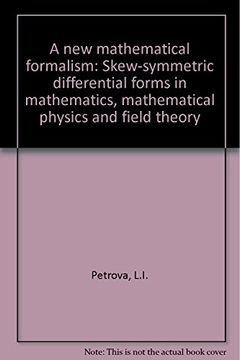A new Mathematical Formalism: Skew-Symmetric Differential Forms in Mathematics, Mathematical Physics and Field Theory (en Inglés)
Reseña del libro "A new Mathematical Formalism: Skew-Symmetric Differential Forms in Mathematics, Mathematical Physics and Field Theory (en Inglés)"
Encuadernación: Rústica.Skew-symmetric differential forms possess unique capabilities that manifest themselves in various branches of mathematics and mathematical physics. The invariant properties of closed exterior skew-symmetric differential forms lie at the basis of practically all invariant mathematical and physical formalisms. Closed exterior forms, whose properties correspond to conservation laws, explicitly or implicitly manifest themselves essentially in all formalisms of field theory. In the present work, firstly, the role of closed exterior skew-symmetric differential forms in mathematics, mathematical physics and field theory is illustrated, and, secondly, it is shown that there exist skew-symmetric differential forms that generate closed exterior differential forms. These skew-symmetric forms are derived from differential equations and possess evolutionary properties. The process of extracting closed exterior forms from evolutionary forms enables one to describe discrete transitions, quantum jumps, the generation of various structures, origination of such formations as waves, vortices and so on. In none of other mathematical formalisms such processes can be described since their description includes degenerate transformations and transitions from nonintegrable manifolds to integrable ones.The unique role played by skew-symmetric differential forms in mathematics and mathematical physics, firstly, is due to the fact that they are differentials and differential expressions, and, therefore, they are suitable for describing invariants and invariant structures. And, secondly, skew-symmetric forms have a structure that combines objects of different nature, namely, the algebraic nature of the form coefficients and the geometric nature of the base. The interaction between these objects enables to describe evolutionary processes, discrete transitions, the realization of conjugacy of operators or objects, the emergence of structures and observable formations, and so on. IntroductionChapter 1. Role of skew-symmetric differential forms in mathematics1. Exterior differential forms1.1. Closed exterior differential forms1.2. Properties of the closed exterior forms1.3. Invariance as the result of conjugacy of elements of exterior or dual forms1.4. Specific features of the mathematical apparatus of exterior differential forms1.5. Connection between exterior differential forms and various branches of mathematics1.6. Qualitative investigation of the functional properties of the solutions to differential equations2. Evolutionary skew-symmetric differential forms2.1. Some properties of manifolds2.2. Properties of the evolutionary differential forms2.3. Specific features of the mathematical apparatus of evolutionary differential forms. Generate closed external forms2.4. Functional possibilities of evolutionary formsCharacteristics of the differential-geometrical structures realizedClassification of differential-geometrical structures realizedBibliographyChapter 2. Role of skew-symmetric differential forms in Mathematical Physics and Field Theory1. Role of closed exterior differential forms in mathematical physics and field theory1.1. Some specific features of closed exterior differential forms1.2. Closed exterior forms as the basis of field theories2. Role of evolutionary skew-symmetric differential forms in mathematical physics and field theory2.1. Mechanism of generation of closed exterior forms corresponding to the conservation laws for physical fields2.2. Mechanism of evolutionary processes in material systems2.3. Connection between the field-theory equations and the equations of conservation laws for material systems3. Specific features and physical meaning of the solutions to equations of mathematical physics and field theoryConclusionBibliographyChapter 3. Conservation laws. Generation of physical structures. Principles of field theoriesIntroduction1. Conservation laws1.1. Exact conservation laws1.2. Balance conservation laws2. Connection between physical fields and material systems. Generation of physical fields3. Basic principles of existing field theories4. On foundations of field theoryAppendixBibliographyChapter 4. The effect of noncommutativity of the conservation laws on the development of thermodynamical and gas dynamical instability1. Analysis of principles of thermodynamics2. The development of the gas dynamic instabilityBibliographyChapter 5. The development of gas dynamical instability. Mechanism of origination of vorticity and turbulenceBibliographyChapter 6. Qualitative investigation of Hamiltonian systems by application of skew-symmetric differential formsBibliographyChapter 7. Electromagnetic fieldBibliographyChapter 8. Formation of physical fields and manifolds1. Classification of physical structures and physical fields (Parameters of the closed exterior and dual forms)2. Formation of pseudometric and metric spacesBibliographyChapter 9. On integrability of equations of mathematical physics1. Analysis of partial differential equations that describe real processes2. Integrability of the equations of mechanics and physics of continuous medium3. Analysis of the field-theory equationsBibliographyChapter 10. Foundations of field theory1. Closed inexact exterior forms is the basis of field theories2. Mathematical apparatus of evolutionary differential forms as the basis of general field theory3. Connection between the equations of field-theory and the equations for material systems3.1. Specific features of the equations of mathematical physics3.2. Peculiarities of nonidentical evolutionary relation3.3. Role of nonidentical evolutionary relation as the equation of general field theoryBibliographyConclusion

